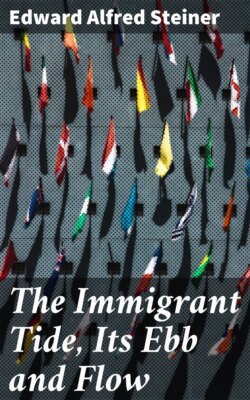Читать книгу The Immigrant Tide, Its Ebb and Flow - Edward Alfred Steiner - Страница 3
На сайте Литреса книга снята с продажи.
PREFACE
ОглавлениеTable of Contents
“PUT your hand on this cable,” the captain said; and a dozen hands grasped it before it sank back into the sea. Our fingers felt no thrill or shock, for we had touched only the incasing insulation. Then the captain told its length, stretching along the ocean’s depths, its weight and cost; but the figures falling upon our ears roused no emotions; for they gave no idea of the cable’s value to society.
On shore we were taken into a dark chamber and there saw flashes of light, which lived but a moment; yet each spark was a letter, holding some hidden meaning, revealing some vital truth. Here the imagination was stirred and the mighty significance of the cable comprehended.
There are two ways in which to reveal the import of those vital connections between the continents, as established by the immigration of European peoples to America. One way is to record its volume, measure its fluctuations, classify the different groups and statistically determine the value of this movement to them; to trace the effect upon its sources and its significance to the country which receives them.
The state of New York and the government of the United States, through their Immigrant Commissions, have attempted to do this from the statistical standpoint with material gathered by observers, more or less skilled. The difficulties involved in this method are very great, especially if the result is to furnish a test of the desirability of one race or nationality over another, or determine its value to our civilization. A race may be homogeneous in its historical or racial consciousness, but heterogeneous in its cultural development. This is true of the Slavs, the Latins and the Semitic peoples who make up the bulk of our immigrant population.
Not only is there a number of well defined racial groups, but each group needs to be sub-divided, and those subdivisions in turn have many divisions; for every mountainside has its own traditions and each valley holds different ideals. For instance: I know of one Slav village in Hungary in which illegitimacy is unknown; yet within two or three miles there is a village in which it is the rule rather than the exception. I know some villages in the Carpathians, so remote from civilization that the inhabitants have not yet learned how to make bread with yeast, and I know other villages in the same locality in which are culinary artists who make a cake having national fame.
A man may be a Polish peasant and be a semi-barbarian or he may be on the same cultural level as the German “bauer” at his best.
The statistical method is of value; but it must be exceedingly painstaking, and even then I doubt that it can serve in all cases the purpose for which it is intended.
I have therefore chosen the second, the interpretative method. It sees the sparks in the dark room, it interprets the flying flame and feels the influences on both sides of the sea. It crosses and recrosses the ocean with these human cables which bind together the continents; it listens to their stories and records them, hesitatingly draws conclusions and undogmatically tries to teach some lessons.
In the first part of my book I have tried to show the influences of the returned immigrant upon his peasant home and his social and national life. In the second part I interpret the relation of various races to our institutions, their attitude towards them and their influence upon them.
In all I have told, I have aspired to be an interpreter and not an enumerator; a mediator and not a critic; I have desired to create contacts and not divisions; to disarm prejudice and not give it new weapons.
In this book, as in all the others I have written, I am indebted to my wife; not only for doing all the tedious tasks such work involves, but also for inspiration and the creation of an atmosphere in which I could write in superlative terms of American ideals.
I wish to acknowledge the courtesy of the editors of the Outlook and the Review of Reviews in permitting me to reprint portions of this book.
I heartily thank the Y. M. C. A. of Pennsylvania and Mr. E. B. Buckalew, its efficient State Secretary, for the opportunity to gather material in that state and in Europe; the young men who made up the Pennsylvania Expedition for the Study of Immigration, who were helpful, joyous comrades, and the trustees of Grinnell College, Iowa, for a generous leave of absence.
E. A. S.
Grinnell, Iowa, August, 1909.
